| Home | Release List | Coupons | Shop | Reviews | Forum | Video Games | Price Search | Advertise |

| DVD & MOVIE REVIEWS |
|
|
| DVD TALK FORUM |
| REVIEWS & COLUMNS |
|
• DVD Reviews • Theatrical Reviews • Video Game Reviews • Adult DVD Reviews • DVD Interviews • The Aisle View • • Cinema Gotham • CineSchlock-O-Rama • DVD Savant • Our Week
|
| SHOP |
|
• Adult DVD Empire • Amazon.com (DVD) • Buy.com • DeepDiscountDVD • DVD Empire • DVD Overnight • Ebay • Half.com • HKFlix.com • HTMarket.com • Complete List of Stores |
| DVD RESOURCE |
|
• DVD Talk Forum • DVD Price Search • Store Ratings • Customer Service #'s • DVD FAQ • Regional Encoding Info • Links |
| DVDTALK INFO |
|
• About DVD Talk • Advertise • Contribute • Tell A Friend • Newsletter Subscribe • Join DVD Talk Forum |
 |
Those Astral Collision Movies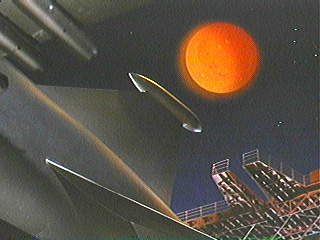 The Sky is Falling! THE science fiction sub-genre for the Millenium!
The Sky is Falling! THE science fiction sub-genre for the Millenium!
As the end of the century drew near Hollywood responded by cooking up a slew of warmed-over end-of-the-world sagas involving giant interstellar objects on disastrous collision courses with Earth. Just when it looked as if the movies had run out of faceless, nameless enemies for America to defeat, a startling new foe appeared on the horizon: Serious scientists speculated that giant meteors capable of wiping out Terra Firma actually could be heading our way. First, the Hubbell orbiting telescope caught sensational pix of a string of meteors punching a row of colossal holes in Jupiter. Then the news reported a giant object heading our way, only to retract the story the next day with the word that whatever it was would miss us by millions of miles. No matter. First Asteroid became a TV movie and then the big budgeted Deep Impact and Armageddon landed in 1998, or would have had it not been for the intervention of intrepid astronauts. These three new examples are only the tip of the meteor, so to speak, of a science fiction sub-genre that some say began with the brouhaha over the passing of Halley's Comet back near the turn of the century. Even before then, Jules Verne wrote Off On a Comet, which grazes the Earth carrying away a bit of North Africa along with some colorful French characters hanging on by their fingernails. The happy ending has the comet logically circling the sun to redeposit the bit of our planet right where it found it, restoring our heroes back where they started! Some of the highlights of the Astral Collision genre are: 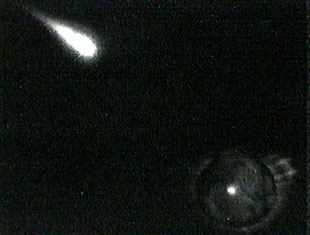
1) Abel Gance's 1930 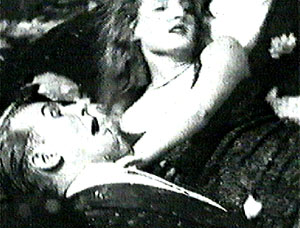
The rather convincing orgy (those shots in the docu are pretty hot!) was apparently achieved by gathering a couple hundred wild and willing Parisian actors, letting the wine flow, locking the stage doors and shouting 'Orgy! Action!' or the French equivalent. Contemporary reviewers were too busy criticizing Abel Gance's ego and fiscal irresponsibility to take a good look at the film. Gance gave himself the starring role, one that allowed him to be crucified Christ-like. As with several other Gance productions his backers revolted, took the film from him, and finished it without his participation. Note, 8/07: Savant has given La fin du monde a full review. 2) George Pal's WHEN WORLDS COLLIDE is a 1951 best special effects Oscar winner that was written and prepared for Cecil B. DeMille in the early 1930s, perhaps in response to the Gance film. The literary source were two novels by Wylie and Balmer, When Worlds Collide and After Worlds Collide, so popular they remain in print to this day. Despite the fact that they are filled with a racist loathing for anything Asian and are overrun with cockeyed religous symbolism, the books were standard fare in school libraries of the '60s. Devout producer Pal retained the Christ metaphor of the books that made the stellar apocalypse into a thinly disguised Second Coming. Two heavenly bodies, the planet Bronson Alpha (or Bellus in the film) and its smaller satellite Bronson Beta (Zyra) will intersect Earth's orbit in only eight months. Bellus, representing the Old Testament Jehovah, will smash the Earth to pulp, killing every living soul. No simple flood this time, folks. But Earth has a second chance. A few weeks before the Bellus impact its moon Zyra, representing Jesus Christ, will pass close by our planet and cause massive earthquakes, tidal waves and other assorted havoc. Only the Chosen Few will be saved, those technocrats that believe in science and are daring enough to build Space Arks to fly to Zyra. 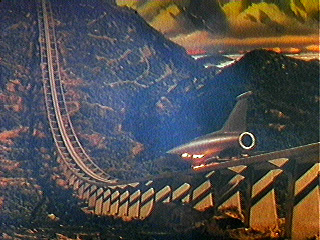
Seen today When Worlds Collide is a naïve but charming hoot. It begins and ends with the ponderous opening and closing of a Bible. Bellus, schmellus, we know who's really wiping out the Earth! The inside of the Space Ark is arrayed like a church with the faithful in the pews and the pilots (churchmen?) up in the pulpit. The chosen passengers really seem to be some kind of Elect, for their equally altruistic peers left behind immediately riot like hooligans to steal seats on the only ride off the planet. Scientific details are curious, especially from the maker of the fastidiously accurate Destination Moon. Eight months isn't long enough to design and perfect a pencil sharpener but the Arkians research, design, test and build an incredibly advanced rocketship as civilization crumbles around them, no less. The (admittedly cool-looking) Space Ark is launched from a ramp that goes down into a valley before zooming up the next mountainside. Speaking of fuel, the fuel gauge on this super rocket is a simple indicator marked 'full', 'half' and 'empty'. Domestic farm animals are brought on board literally two by two, Noah-style, as if a single pair of animals could restore a species. The only preparation for arrival on Zyra is a crash landing, which is accomplished on a field of snow in the mountains. Previous glimpses of the terrain show only snow and dense clouds for hundreds of miles. Yet when the hatch is opened, the view awaiting the Arkians is that of a verdant paradise complete with an inspirational sunset and an unexplained (unless one takes into account the book After Worlds Collide 1) pyramid-like structure on the horizon. Typical is the scene where the cocksure pilot throws open the airlock without first testing the atmosphere because, "It's the only place we can go!" The dramatic and moral logic of When Worlds is just as thoughtlessly presented as its science. Essential Ark personnel risk their lives pointlessly taking supplies to flood survivors who are doomed anyway. During the lottery for the forty seats on the Ark none of the young engineers and scientists offers the least objection when the head of the project arbitrarily reserves space for his daughter, her boyfriend, a kid rescued from a rooftop and a stray dog! The project leader also bends the rules to allow yet another lottery loser to take cuts in the line for the Ark, to stay with her boyfriend. No wonder the losers are rioting! And yet the multimillionaire investor who bankrolls the Ark is refused a ticket to ride because he's a cynical malcontent. How his riches made the Ark possible is a mystery, when a big point is made that, with the world ending, money no longer has any value. A cripple restricted to a wheelchair, he prefigures Doctor Strangelove when the coming of doomsday unaccountably restores his ability to walk. By the way, Savant adores When Worlds Collide. (note: 4.05.06 revision) A special edition DVD has been released for Pal's War of the Worlds; hopefully Collide won't be far behind. 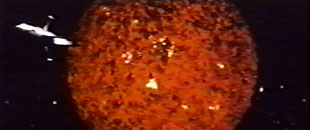
3) 1962's GORATH (Yosei Gorasu) is a Japanese version of the same story but with telling cultural differences. In Tohoscope and color, the film is the final part of an unofficial trilogy of space-oriented Science fiction begun in 1957 with Chikyu Boeigun (The Mysterians) and Uchu Daisenso (Battle in Outer Space). The original Japanese version has its share of inane comedy relief and bizarre cultural digressions, such as a plane-load of space-happy astronauts singing like idiots. There's also a fall-down funny dance scene where the really swingin' spacemen go through some perfectly awful choreographed moves as if they were the hippest guys in town. But the rest of the drama is uncommonly touching and deftly judged. The spirit of group effort and self-sacrifice in the attempt to save the world from the oncoming planetoid Gorath is infectious. A spaceship sent to intercept Gorath finds itself unable to escape the planetoid's exaggerated gravitational field. Rather than struggle further, the astronauts gamely elect to concentrate on sending data on Gorath back to Earth. They toast their suicidal gesture with cheers of Banzai! Instead of seeming foolish, the scene comes off as inspirational. It betters by far the mock heroics in Armageddon. 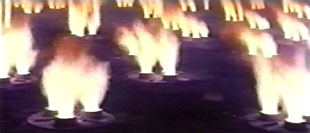
Even though the eventual plan to save the Earth is absurd (rockets are built in Antarctica to push Earth from its orbit, out of the way of Gorath) the human dimension is never less than compelling. Unlike any other Japanese science fiction movie Savant has seen, Gorath's dramatics outweigh the visuals. The final countdown to Gorath's passing is gripping. If only the obvious model work were a little bit better! The machines digging at the South Pole are pitiful toys and Gorath itself looks like a glowing Caramel-coated apple. 
One weird touch is the appearance of a giant Arctic walrus disturbed by the construction. Unusual for Toho, the scientists regret the necessity of killing the essentially benign behemoth, and summarily dismember it with ray guns. The sight of the pitiful, huge carcass adds to the emotional curve of the story: it's surprisingly sad when military weapons prove effective against a Kaiju monster. Of the three films above, only When Worlds Collide is available on DVD, and the other two are much more difficult to see in the U.S.. Savant caught Gorath on an imported Toho VHS, augmented with subtitles. Gorath was released by more than one distributor in the states. Twenty minutes were cut out and the film was given a horrendously poor dubbing job, even worse than the average Godzilla epic. Not only were the comical (read: must-see) highlights with the fun-loving astronauts excised, but the entire episode with the Giant Walrus was removed as well. 1. It seems that George Pal did a temporary final shot for When Worlds Collide using a quick oil study for the final vista of Zyra. He learned the lesson many a special effects vendor has learned: Paramount said 'Looks great to us!' and ordered the cut locked. That's why Collide ends with Zyra looking like a background in a Road Runner cartoon. Pal had envisioned a vista combining a 3-D miniature and mattes, like one of the planetscapes seen in the beginning of War of the Worlds. The fact that the artist added After Worlds Collide- style pyramids shows the end painting was never meant to be used. Nobody was planning a sequel film, as the final shot implies. Return
Text © Copyright 1998,1999 Glenn Erickson
DVD Savant Text © Copyright 1997-2001 Glenn Erickson
|
| Coming Soon |
|
|
| Special Offers |
|
|
| Columns |
| Home | Release List | Coupons | Shop | Reviews | Forum | Video Games | Price Search | Advertise |
 Like SCIENCE FICTION? Try the following SAVANT
entries!
Like SCIENCE FICTION? Try the following SAVANT
entries! 



